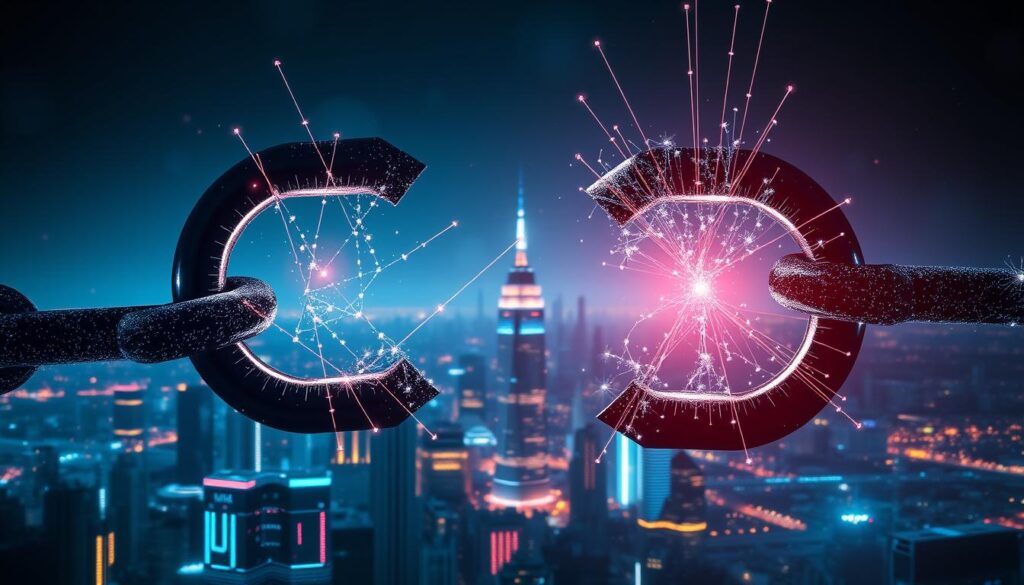Now Reading: Tokenized Securities: A Comprehensive Guide to Getting Started
- 01
Tokenized Securities: A Comprehensive Guide to Getting Started
Tokenized Securities: A Comprehensive Guide to Getting Started

Traditional finance is undergoing a radical shift. Blockchain technology now enables stocks, bonds, and real estate to exist as digital assets on decentralized networks. This innovation unlocks faster settlements, broader access, and real-time transparency – features long missing from conventional markets.
McKinsey predicts this sector could grow to $2 trillion by 2030. BlackRock CEO Larry Fink recently emphasized its potential: “Every stock, every bond… will be on one general ledger.” Unlike cryptocurrencies, these blockchain-based tokens represent real-world value while maintaining regulatory compliance.
This guide breaks down how tokenized securities merge legacy systems with cutting-edge tech. We’ll explore their role in democratizing investments and why institutions like BlackRock champion this evolution. From fractional ownership to automated compliance, the benefits are reshaping how we interact with financial markets.
Key Takeaways
- Blockchain converts traditional investments into tradable digital tokens
- Market value could hit $2 trillion within six years (McKinsey)
- Differs from crypto by tying directly to regulated assets
- Enables 24/7 trading and smaller investment increments
- Major firms like BlackRock see tokenization as finance’s next phase
Exploring the World of Tokenized Securities
Imagine owning a piece of Manhattan real estate or blue-chip stocks through your digital wallet. Blockchain-powered digital assets make this possible by transforming conventional investments into programmable tokens. These innovations merge Wall Street’s rigor with Silicon Valley’s speed.
Defining Tokenized Securities and Their Impact
At their core, these blockchain-based tokens act as digital twins of stocks, bonds, or property deeds. Each token reflects legal ownership rights verified through smart contracts. Unlike crypto coins, their value comes from physical buildings, company shares, or government debt instruments.
This fusion creates seismic shifts. Investors gain access to markets previously limited to institutions. Trading happens round-the-clock without brokers. Compliance gets automated through code – no paperwork delays.
An Introduction to Digital Assets and Blockchain
Blockchain serves as the backbone for this transformation. Its decentralized ledger records every transaction immutably, cutting fraud risks. Real estate tokens might represent partial stakes in buildings, while equity tokens could mirror Tesla shares.
Major banks now tokenize treasury bonds, and hedge funds issue tokens for private equity deals. This tech doesn’t replace traditional financial assets – it supercharges them with transparency and liquidity previously unimaginable.
Understanding the Fundamentals of Tokenization
Converting tangible assets into blockchain-based tokens requires precise technical orchestration. This process transforms physical or financial holdings into programmable units while preserving legal rights. Let’s explore how traditional investments become next-generation digital securities.

The Process of Converting Assets into Digital Tokens
Four stages define asset tokenization:
- Asset Sourcing: Legal teams verify ownership and regulatory compliance for the physical or financial asset.
- Digital Issuance: Blockchain networks mint tokens representing fractional or full ownership, stored in secure wallets.
- Market Distribution: Tokens become tradable on specialized platforms, enabling 24/7 peer-to-peer transactions.
- Ongoing Management: Smart contracts automate dividends, voting rights, and regulatory reporting.
Differences Between Tokenized Securities and Cryptocurrencies
While both use blockchain, key distinctions exist:
- Value Source: Tokens derive worth from underlying assets like real estate. Cryptocurrencies have value through network adoption.
- Regulation: Tokens comply with securities laws. Most cryptocurrencies operate in less-regulated spaces.
- Function: Tokens represent ownership rights. Crypto often serves as currency or speculative asset.
This framework merges legacy financial systems with blockchain’s efficiency – creating tradable tokens without sacrificing legal safeguards.
Technology Behind Tokenized Securities
The engine powering modern financial innovation lies in distributed systems that redefine trust. Blockchain acts as a shared database where transactions get recorded across thousands of computers simultaneously. This architecture ensures no single entity controls the data – a breakthrough for markets requiring transparency.
Role of Distributed Ledger and Blockchain Technology
Distributed ledgers form the backbone of this system. Unlike traditional databases, they spread copies of transaction records across multiple locations. Three pillars define their value:
- Decentralization: Eliminates central authority vulnerabilities
- Immutability: Records can’t be altered after validation
- Consensus: All network nodes must agree on new entries
Every transaction creates a cryptographic “block” linked to previous ones. Nodes – computers in the network – verify each block using algorithms. Once approved, the chain updates globally in seconds. This process slashes settlement times from days to minutes.
Financial institutions now leverage these features to solve age-old problems. A recent SEC roundtable highlighted how blockchain’s audit trail reduces reconciliation errors. Scalability solutions like layer-2 networks address throughput concerns, enabling large-scale adoption.
Through smart automation and shared verification, blockchain technology reshapes how ownership gets tracked. The result? Markets where every participant shares identical, real-time truth.
How Blockchain and Smart Contracts Enhance Efficiency
Financial markets have long been slowed by manual processes and paperwork. Blockchain and self-executing code now rewrite these rules, turning days-long tasks into instant digital operations. This shift unlocks new levels of speed and accuracy across investment workflows.

Automation Through Programmable and Composable Assets
Smart contracts act as robotic accountants embedded in digital assets. They automatically trigger actions like dividend payouts when specific conditions occur. A bond token might calculate interest daily, while a stock token could process shareholder votes without brokers.
These programmable features enable assets to interact seamlessly. Imagine a real estate token that pays rent directly into your wallet, then automatically reinvests it into another property token. This composability creates financial ecosystems that adapt in real time.
Improving Settlement Processes with Instant Transactions
Traditional settlement systems take two business days (T+2) to finalize trades. Blockchain collapses this timeline to seconds. When you buy a tokenized asset, ownership updates instantly across the network’s ledger.
This speed matters most in volatile markets. A 2023 JPMorgan trial showed blockchain settlements reduced failed trades by 95%. Banks now use this tech to slash operational costs, with some reporting 40% savings in trade processing.
By merging blockchain infrastructure with smart contract logic, financial systems achieve unprecedented efficiency. The result? Markets that work faster, cheaper, and with fewer errors – exactly what modern investors demand.
Getting Started with Investment in Tokenized Securities
Breaking into blockchain-based investing requires a strategic approach. Specialized platforms now let investors trade fractional ownership of real estate, fine art, and corporate debt. For a comprehensive analysis of tokenized securities, review regulatory frameworks and market trends before diving in.
Steps to Tokenize Traditional Financial Assets
Follow this seven-step framework to navigate the emerging digital market:
- Platform Selection: Identify regulated exchanges like Securitize or tZERO that offer access to vetted opportunities
- Enhanced Verification: Complete KYC/AML checks exceeding standard crypto requirements – expect document submissions and biometric scans
- Asset Analysis: Study prospectuses detailing the underlying asset’s valuation, cash flows, and risk factors
- Legal Review: Scrutinize smart contract terms for ownership rights, profit distribution, and exit clauses
- Liquidity Check: Confirm secondary trading options – some tokens lock funds for specific periods
- Secure Storage: Use institutional-grade wallets like Fireblocks for asset protection
- Test Investments: Allocate 1-5% of your portfolio to build practical knowledge
Successful investors combine due diligence with technical readiness. Start with small positions to understand settlement times and trading mechanics. As markets evolve, these digital instruments could redefine access to global wealth-building opportunities.
Tokenized Securities: Benefits for Modern Investors
Modern investors demand flexibility and efficiency in their portfolios. Blockchain-powered solutions deliver both by redefining how we access and manage value. From eliminating geographic barriers to automating complex processes, these innovations create opportunities once reserved for institutional players.

Fractional Ownership and 24/7 Trading Advantages
Fractional ownership shatters minimum investment thresholds. Now, $500 can buy a slice of Manhattan skyscrapers or rare collectibles. This approach diversifies risk while opening markets like tokenized real-world assets to everyday investors.
Trading never sleeps. Unlike stock exchanges that close at 4 PM ET, blockchain markets operate 24/7. Buy or sell shares in a Tokyo office building during a New York midnight. Real-time settlements replace the traditional T+2 waiting period, freeing capital faster.
Enhanced Transparency and Reduced Intermediaries
Every transaction lives permanently on-chain. Investors track ownership changes and dividend payments in public ledgers. No more guessing about asset histories or relying on third-party reports.
Cutting brokers and custodians slashes fees by up to 70%. Smart contracts handle escrow and compliance automatically. This direct access model benefits both new entrants and seasoned traders seeking cost-efficient strategies.
Liquidity improves as markets globalize. A farmer in Iowa can now sell partial stakes in Brazilian farmland to buyers in Singapore. Blockchain’s borderless nature turns local assets into internationally tradable positions overnight.
Managing Risks and Regulatory Challenges
Investors entering digital markets face dual challenges: evolving regulations and emerging technical threats. While blockchain offers innovation, it operates within existing legal frameworks requiring strict adherence. Understanding these hurdles separates savvy participants from vulnerable speculators.
Navigating Compliance in the United States
The SEC treats tokenized stocks and bonds like traditional securities. Issuers must follow registration rules or qualify for exemptions like Regulation D. Public offerings require detailed disclosures about asset valuations and revenue models.
Three critical compliance steps:
- Legal classification: Determine if tokens qualify as securities under Howey Test criteria
- Reporting systems: Implement automated tools for investor accreditation checks
- State coordination: Address Blue Sky laws in all operating jurisdictions
Addressing Security and Technical Vulnerabilities
Blockchain’s transparency doesn’t eliminate risks. Smart contract flaws caused $1.8 billion in losses during 2023, per Chainalysis data. Custody solutions require military-grade encryption for private keys and multi-signature protocols.
Essential protection measures:
- Use audited platforms with insurance coverage
- Enable two-factor authentication on all accounts
- Verify wallet addresses before transactions
Regulators increasingly target fraudulent trading platforms. The CFTC recently charged three firms for offering unregistered security tokens. Staying informed through official SEC alerts helps avoid costly missteps.
Real-Life Examples and Innovations in Asset Tokenization
Concrete applications prove blockchain’s financial revolution isn’t theoretical. Major institutions and property developers now demonstrate how digital ownership models create tangible value. From skyscrapers to vacation resorts, real-world assets are finding new liquidity through blockchain innovation.
Pioneering Projects Rewriting Ownership Rules
BlackRock, WisdomTree, and Franklin Templeton made headlines in early 2024. Their blockchain-based money market funds collectively surpassed $1 billion in value, signaling institutional confidence. These products let investors earn yields while maintaining instant redemption capabilities.
The real estate sector shows equally bold experiments. A Manhattan luxury condo development became one of the first tokenized properties in 2018, converting $30 million worth of units into tradeable digital shares. More recently, the St. Regis Aspen Resort used Aspen Coins to raise $18 million, letting buyers own fractions of the Rocky Mountain retreat.
Commercial properties join the movement through projects like Alterra Worldwide’s T27 Tower. This $60 million San Jose office complex now offers blockchain-based ownership stakes. Investors can trade commercial property shares like stocks – a radical shift from traditional real estate transactions.
These cases reveal a pattern: asset tokenization works best for high-value, illiquid assets. By combining regulatory compliance with blockchain’s efficiency, developers unlock global capital pools while giving everyday investors access to premium opportunities.
FAQ
How do blockchain-based assets differ from traditional investments?
Blockchain-based assets use distributed ledgers to represent ownership digitally, enabling fractional shares and instant transfers. Unlike traditional investments, they operate 24/7 on global markets with reduced reliance on brokers or custodians.
What makes real estate a popular choice for tokenization?
Real estate tokenization breaks high-value properties into affordable digital shares. Investors gain partial ownership without large upfront costs, while blockchain ensures transparent records of transactions and property rights.
Are programmable assets legally recognized in the U.S.?
Yes, programmable assets must comply with SEC regulations like Regulation D or A. Smart contracts encode legal terms, ensuring automated compliance with dividend payments, voting rights, or profit-sharing agreements.
Can tokenization reduce settlement times for trades?
Blockchain eliminates intermediaries like clearinghouses, enabling near-instant settlement. Transactions that took days now finalize in minutes, lowering costs and counterparty risks.
How do smart contracts improve trust in digital securities?
Smart contracts execute predefined rules automatically, such as distributing dividends or enforcing ownership transfers. This reduces human error and ensures terms are applied consistently across all parties.
What risks should investors consider with tokenized bonds or funds?
Technical vulnerabilities, like coding errors in smart contracts, could expose assets to exploits. Regulatory changes or tax reporting complexities also require careful due diligence before investing.
Which industries are adopting tokenization beyond real estate?
Art, private equity, and commodities like gold are being tokenized. Companies like Securitize and platforms such as tZERO enable fractional ownership of venture capital funds or rare collectibles.
How does fractional ownership expand market access?
By dividing assets into smaller units, tokenization lets smaller investors participate in markets previously reserved for institutions. This democratizes access to high-value opportunities like commercial properties or private equity.













